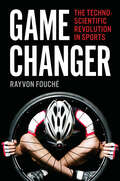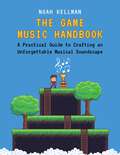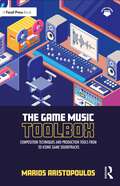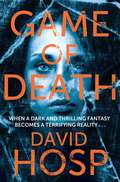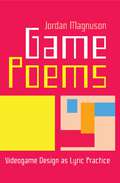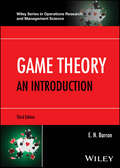- Table View
- List View
Game Changer: The Technoscientific Revolution in Sports
by Rayvon FouchéWe like to think of sports as elemental: strong bodies trained to overcome height, weight, distance; the thrill of earned victory or the agony of defeat in a contest decided on a level playing field. But in Game Changer, Rayvon Fouché argues that sports have been radically shaped by an explosion of scientific and technological advances in materials, training, nutrition, and medicine dedicated to making athletes stronger and faster. Technoscience, as Fouché dubs it, increasingly gives the edge (however slight) to the athlete with the latest gear, the most advanced training equipment, or the performance-enhancing drugs that are hardest to detect. In this revealing book, Fouché examines a variety of sports paraphernalia and enhancements, from fast suits, athletic shoes, and racing bicycles to basketballs and prosthetic limbs. He also takes a hard look at gender verification testing, direct drug testing, and the athlete biological passport in an attempt to understand the evolving place of technoscience across sport. In this book, Fouché: • Examines the relationship among sport, science, and technology• Considers what is at stake in defining sporting culture by its scientific knowledge and technology• Provides readers and students with an informative and engagingly written studyFocusing on well-known athletes, including Michael Phelps, Oscar Pistorius, Caster Semenya, Usain Bolt, and Lance Armstrong, Fouché argues that technoscience calls into question the integrity of games, records, and our bodies themselves. He also touches on attempts by sporting communities to regulate the use of technology, from elite soccer's initial reluctance to utilize goal-line technology to automobile racing's endless tweaking of regulatory formulas in an attempt to blur engineering potency and reclaim driver skill and ability. Game Changer will change the way you look at sportsâ€�and the outsized impact technoscience has on them.
Game Design Deep Dive: Role Playing Games
by Joshua BycerGame Design Critic Josh Bycer is back with another entry in the Game Design Deep Dive series to discuss the Role-Playing Game genre. Arguably one of the most recognizable in the industry today, what is and what isn’t an RPG has changed over the years. From the origins in the tabletop market, to now having its design featured all over, it is one of the most popular genres to draw inspiration from and build games around. This is a genre that looks easy from the outside to make, but requires understanding a variety of topics to do right. • A breakdown of RPG mechanics and systems, perfect for anyone wanting to study or make one themselves • The history of the genre – from tabletop beginnings to its worldwide appeal • The reach of the genre – a look at just some of the many different takes on RPGs that have grown over the past 40 years • An examination of how RPG systems can be combined with other designs to create brand new takes
Game Design Deep Dive: Role Playing Games
by Joshua BycerGame Design Critic Josh Bycer is back with another entry in the Game Design Deep Dive series to discuss the Role-Playing Game genre. Arguably one of the most recognizable in the industry today, what is and what isn’t an RPG has changed over the years. From the origins in the tabletop market, to now having its design featured all over, it is one of the most popular genres to draw inspiration from and build games around. This is a genre that looks easy from the outside to make, but requires understanding a variety of topics to do right. • A breakdown of RPG mechanics and systems, perfect for anyone wanting to study or make one themselves • The history of the genre – from tabletop beginnings to its worldwide appeal • The reach of the genre – a look at just some of the many different takes on RPGs that have grown over the past 40 years • An examination of how RPG systems can be combined with other designs to create brand new takes
Game Design for Free-to-Play Live Service (Synthesis Lectures on Image, Video, and Multimedia Processing)
by Stanislav Stanković"Game Design for Free to Play Live Service" is the ultimate guide to designing successful free-to-play mobile games. Based on a decade of experience at companies like Rovio, EA, and Supercell, the author provides practical advice on gameplay mechanics, monetization strategies, and player engagement. With case studies and expert insights, this book is essential reading for any game developer looking to create a hit mobile game.
Game Dev Stories Volume 1: Interviews About Game Development and Culture
by David L. CraddockGame Dev Stories: Interviews About Game Development and Culture Volumes 1 and 2 are a collection of interviews from renowned author David L. Craddock as he explores all corners of the video game industry. Collected from the author's archives, Game Dev Stories gathers conversations with individuals from all corners of the industry: Who they are, the paths they paved, and their contributions to this multibillion-dollar industry. This text offers viewpoints from well-known individuals like John Romero, Tom Hall, and Matt Householder. From artists and writers to programmers and designers, Game Dev Stories offers amazing insights and understanding to what occurs behind the screens of your favorite games and may help inspire future game developers in pursuing their dreams. Author Bio David L. Craddock writes fiction, nonfiction, and grocery lists. He is the author of over a dozen nonfiction books about video game development and culture, including the bestselling Stay Awhile and Listen series, Arcade Perfect: How Pac-Man, Mortal Kombat, and Other Coin-Op Classics Invaded the Living Room, and fiction for young adults, including The Dumpster Club and Heritage: Book One of the Gairden Chronicles. Find him online @davidlcraddock on Twitter.
Game Dev Stories Volume 1: Interviews About Game Development and Culture
by David L. CraddockGame Dev Stories: Interviews About Game Development and Culture Volumes 1 and 2 are a collection of interviews from renowned author David L. Craddock as he explores all corners of the video game industry. Collected from the author's archives, Game Dev Stories gathers conversations with individuals from all corners of the industry: Who they are, the paths they paved, and their contributions to this multibillion-dollar industry. This text offers viewpoints from well-known individuals like John Romero, Tom Hall, and Matt Householder. From artists and writers to programmers and designers, Game Dev Stories offers amazing insights and understanding to what occurs behind the screens of your favorite games and may help inspire future game developers in pursuing their dreams. Author Bio David L. Craddock writes fiction, nonfiction, and grocery lists. He is the author of over a dozen nonfiction books about video game development and culture, including the bestselling Stay Awhile and Listen series, Arcade Perfect: How Pac-Man, Mortal Kombat, and Other Coin-Op Classics Invaded the Living Room, and fiction for young adults, including The Dumpster Club and Heritage: Book One of the Gairden Chronicles. Find him online @davidlcraddock on Twitter.
Game Dev Stories Volume 2: More Interviews About Game Development and Culture
by David L. CraddockGame Dev Stories: Interviews About Game Development and Culture Volumes 1 and 2 are a collection of interviews from renowned author David L. Craddock as he explores all corners of the video game industry. Collected from the author's archives, Game Dev Stories gathers conversations with individuals from all corners of the industry: Who they are, the paths they paved, and their contributions to this multibillion-dollar industry. This text offers viewpoints from well-known individuals like John Romero, Tom Hall, and Matt Householder. From artists and writers to programmers and designers, Game Dev Stories offers amazing insights and understanding to what occurs behind the screens of your favorite games and may help inspire future game developers in pursuing their dreams. Author Bio David L. Craddock writes fiction, nonfiction, and grocery lists. He is the author of over a dozen nonfiction books about video game development and culture, including the bestselling Stay Awhile and Listen series, Arcade Perfect: How Pac-Man, Mortal Kombat, and Other Coin-Op Classics Invaded the Living Room, and fiction for young adults, including The Dumpster Club and Heritage: Book One of the Gairden Chronicles. Find him online @davidlcraddock on Twitter.
Game Dev Stories Volume 2: More Interviews About Game Development and Culture
by David L. CraddockGame Dev Stories: Interviews About Game Development and Culture Volumes 1 and 2 are a collection of interviews from renowned author David L. Craddock as he explores all corners of the video game industry. Collected from the author's archives, Game Dev Stories gathers conversations with individuals from all corners of the industry: Who they are, the paths they paved, and their contributions to this multibillion-dollar industry. This text offers viewpoints from well-known individuals like John Romero, Tom Hall, and Matt Householder. From artists and writers to programmers and designers, Game Dev Stories offers amazing insights and understanding to what occurs behind the screens of your favorite games and may help inspire future game developers in pursuing their dreams. Author Bio David L. Craddock writes fiction, nonfiction, and grocery lists. He is the author of over a dozen nonfiction books about video game development and culture, including the bestselling Stay Awhile and Listen series, Arcade Perfect: How Pac-Man, Mortal Kombat, and Other Coin-Op Classics Invaded the Living Room, and fiction for young adults, including The Dumpster Club and Heritage: Book One of the Gairden Chronicles. Find him online @davidlcraddock on Twitter.
Game Engine Gems 2
by Eric LengyelThis book, the second volume in the popular Game Engine Gems series, contains short articles that focus on a particular technique, describe a clever trick, or offer practical advice within the subject of game engine development. The 31 chapters cover three broad categories-graphics and rendering, game engine design, and systems programming. Profess
Game Jams – History, Technology, and Organisation
by Allan Fowler Foaad KhosmoodThis book will provide a comprehensive guide to creating and managing a game jam. The book will also provide an overview of how and where game jams have been held, the type of game jams, the tools and technologies used in organising and participating in game jams.
The Game Music Handbook: A Practical Guide to Crafting an Unforgettable Musical Soundscape
by Noah KellmanDo you want to learn everything you need to know to be a fantastic video game music composer? The Game Music Handbook is for you. This book takes readers on a journey through many of the greatest video game soundscapes to date, discussing key concepts and technical practices for how to create top-level game scores. It organizes game scoring techniques into an applicable methodology that gives readers a clear picture of how to design interactive elements, conceive and create a score, and implement it into the game. Readers will gain a solid understanding of the core techniques for composing video game music, the conceptual differences that separate it from other compositional fields, as well as many advanced techniques and topics essential to excellent game music scoring. These topics include using music to design emotional arc for nonlinear timelines, the relationship between music and sound design, music and immersion, discussion of the player's interaction with audio, and more. For beginning composers, this book makes the learning process as clear as possible. However, it also offers invaluable information for intermediate to advanced readers. It includes discussion of game state and its effect on player interaction, a composer-centric lesson on programming, as well as information on how to work with version control, visual programming languages, procedural audio, and more. It also offers indispensable knowledge about advanced reactive music concepts, scoring for emergent games, music for VR, and other important topics. Overall, this book explores the practical application of player and music interaction through the examination of various techniques employed in games throughout video game history to enhance immersion, emphasize emotion, and create compelling interactive experiences.
The Game Music Handbook: A Practical Guide to Crafting an Unforgettable Musical Soundscape
by Noah KellmanDo you want to learn everything you need to know to be a fantastic video game music composer? The Game Music Handbook is for you. This book takes readers on a journey through many of the greatest video game soundscapes to date, discussing key concepts and technical practices for how to create top-level game scores. It organizes game scoring techniques into an applicable methodology that gives readers a clear picture of how to design interactive elements, conceive and create a score, and implement it into the game. Readers will gain a solid understanding of the core techniques for composing video game music, the conceptual differences that separate it from other compositional fields, as well as many advanced techniques and topics essential to excellent game music scoring. These topics include using music to design emotional arc for nonlinear timelines, the relationship between music and sound design, music and immersion, discussion of the player's interaction with audio, and more. For beginning composers, this book makes the learning process as clear as possible. However, it also offers invaluable information for intermediate to advanced readers. It includes discussion of game state and its effect on player interaction, a composer-centric lesson on programming, as well as information on how to work with version control, visual programming languages, procedural audio, and more. It also offers indispensable knowledge about advanced reactive music concepts, scoring for emergent games, music for VR, and other important topics. Overall, this book explores the practical application of player and music interaction through the examination of various techniques employed in games throughout video game history to enhance immersion, emphasize emotion, and create compelling interactive experiences.
The Game Music Toolbox: Composition Techniques and Production Tools from 20 Iconic Game Soundtracks
by Marios AristopoulosThe Game Music Toolbox provides readers with the tools, models, and techniques to create and expand a compositional toolbox, through a collection of 20 iconic case studies taken from different eras of game music. Discover many of the composition and production techniques behind popular music themes from games such as Cyberpunk 2077, Mario Kart 8, The Legend of Zelda, Street Fighter II, Diablo, Shadow of the Tomb Raider, The Last of Us, and many others. The Game Music Toolbox features: Exclusive interviews from industry experts Transcriptions and harmonic analyses 101 music theory introductions for beginners Career development ideas and strategies Copyright and business fundamentals An introduction to audio implementation for composers Practical takeaway tasks to equip readers with techniques for their own game music The Game Music Toolbox is crucial reading for game music composers and audio professionals of all backgrounds, as well as undergraduates looking to forge a career in the video game industry.
The Game Music Toolbox: Composition Techniques and Production Tools from 20 Iconic Game Soundtracks
by Marios AristopoulosThe Game Music Toolbox provides readers with the tools, models, and techniques to create and expand a compositional toolbox, through a collection of 20 iconic case studies taken from different eras of game music. Discover many of the composition and production techniques behind popular music themes from games such as Cyberpunk 2077, Mario Kart 8, The Legend of Zelda, Street Fighter II, Diablo, Shadow of the Tomb Raider, The Last of Us, and many others. The Game Music Toolbox features: Exclusive interviews from industry experts Transcriptions and harmonic analyses 101 music theory introductions for beginners Career development ideas and strategies Copyright and business fundamentals An introduction to audio implementation for composers Practical takeaway tasks to equip readers with techniques for their own game music The Game Music Toolbox is crucial reading for game music composers and audio professionals of all backgrounds, as well as undergraduates looking to forge a career in the video game industry.
Game of Death
by David HospThe first thing I notice is her face. It is so perfect it seems unlikely that it could ever exist in the real world. Her white skin is flawless, her features perfectly symmetrical, her lips red and wet and full, parting with every gasp. It is her eyes that hold me, though. They are a shade of blue I have never seen, with flecks of gold and crystal, and they are so penetrating it feels as though they are reaching out straight through his eyes into mine, begging me for . . . something. I can't quite make out what it is. It's like those eyes have captured the dialectic of every human emotion that ever mattered - love and hate; ecstasy and terror; comfort and jealousy- and rolled them into a single glance that could level entire cities. I am slaughtered. Imagine being able to create and experience your deepest dreams and your darkest fantasies - Boston entrepreneur and techno whizz kid, Nick Calder, with the help of his long-time friend and colleague, Yvette, has worked on a programme where people can do just that - all from the safety and comfort of their home.NextLife is an exciting young company on the brink of going public which promises its subscribers the chance to experience anything they want. Climb Everest. Dive off the Barrier Reef. Go to a 1970s Rolling Stones concert. Walk the Great Wall of China.But it seems that one of their clients has much more sinister desires.And it involved the girl with the wonderful blue eyes.
Game On!: Gamification, Gameful Design, and the Rise of the Gamer Educator (Tech.edu: A Hopkins Series on Education and Technology)
by Kevin BellThe changing student body in American higher education demands a new approach to teaching, one that moves toward inclusive, hyperpersonalized learning environments that have much in common with games and social media. Kevin Bell;€™s Game On! presents dynamic case studies of gamer educators and game-derived techniques to help instructors creatively formulate their own teaching strategies. Breaking gamefully designed classes into their component parts, Bell analyzes what these classes are actually doing and explains why they work. He offers faculty a rubric to assess their own courses for their propensity to engage students, particularly those from low socioeconomic and high-risk populations. Bell explores how game design, pedagogy, and intrinsic motivators can level the playing field to produce rigorous learning environments that are as addictive to all participants as the latest apps and social media systems. He also discusses best practices, lays out the broader context of computer-mediated teaching and learning, and considers the challenges and opportunities that gamification presents.Instructors would do well to consider the key tenets of successful games if they are to engage and graduate the coming generations of learners. Bell;€™s careful analysis of the theories behind gamification, cognitive science, and instructional design will help them to do just that.
Game On!: Gamification, Gameful Design, and the Rise of the Gamer Educator (Tech.edu: A Hopkins Series on Education and Technology)
by Kevin BellThe changing student body in American higher education demands a new approach to teaching, one that moves toward inclusive, hyperpersonalized learning environments that have much in common with games and social media. Kevin Bell;€™s Game On! presents dynamic case studies of gamer educators and game-derived techniques to help instructors creatively formulate their own teaching strategies. Breaking gamefully designed classes into their component parts, Bell analyzes what these classes are actually doing and explains why they work. He offers faculty a rubric to assess their own courses for their propensity to engage students, particularly those from low socioeconomic and high-risk populations. Bell explores how game design, pedagogy, and intrinsic motivators can level the playing field to produce rigorous learning environments that are as addictive to all participants as the latest apps and social media systems. He also discusses best practices, lays out the broader context of computer-mediated teaching and learning, and considers the challenges and opportunities that gamification presents.Instructors would do well to consider the key tenets of successful games if they are to engage and graduate the coming generations of learners. Bell;€™s careful analysis of the theories behind gamification, cognitive science, and instructional design will help them to do just that.
Game Poems: Videogame Design as Lyric Practice
by Jordan MagnusonScholars, critics, and creators describe certain videogames as being “poetic,” yet what that means or why it matters is rarely discussed. In Game Poems: Videogame Design as Lyric Practice, independent game designer Jordan Magnuson explores the convergences between game making and lyric poetry and makes the surprising proposition that videogames can operate as a kind of poetry apart from any reliance on linguistic signs or symbols. This rigorous and accessible short book first examines characteristics of lyric poetry and explores how certain videogames can be appreciated more fully when read in light of the lyric tradition—that is, when read as “game poems.” Magnuson then lays groundwork for those wishing to make game poems in practice, providing practical tips and pointers along with tools and resources. Rather than propose a monolithic framework or draw a sharp line between videogame poems and poets and their nonpoetic counterparts, Game Poems brings to light new insights for videogames and for poetry by promoting creative dialogue between disparate fields. The result is a lively account of poetic game-making praxis. “Everyone who loves the true power of games will benefit from the treasure trove of insights in Game Poems.” — Jesse Schell, author of The Art of Game Design “Magnuson shines a sensitive and incisive light on small, often moving, videogames.” — D. Fox Harrell, Ph.D., Professor of Digital Media, Computing, and Artificial Intelligence, MIT “[Game Poems] tells a new story about games— that games can be lyrical, beautiful, emotionally challenging—to inspire creators and critics alike.” —Noah Wardrip-Fruin, author of How Pac-Man Eats “Even as the news swells with impending doom for creativity, writing, and text itself, this literate and crafty book pursues poetry not through implacable algorithms but in concrete and personal play. It should be an indispensable guide for anyone who aims to maintain the true, human promise of technical poetics.”—Stuart Moulthrop, coauthor of Twining: Critical and Creative Approaches to Hypertext Narratives “For far too long videogames have flourished – and commanded both capital and attention – in a kind of counterculture that they seem to have created as if ex nihilo for themselves and their players. But we are these players, and their culture has always been integrated with all of our own. In this evenhanded artist-scholar’s ars poetica Jordan Magnuson respects the material cultural specificity of videogames while regarding them through the ‘lens of poetry’ in order to discover – and help create – a practice and an art of Game Poems within the wider field. Magnuson formally, int(erv)entionally embraces this art as lyrically poetic.”—John Cayley, Brown University “In Game Poems, Magnuson listens carefully to videogames, and hears them speak to questions of art, language, and meaning that connect our written past to our software future. Read this book and you will hear it too.”—Frank Lantz, Director, NYU Game Center “Jordan Magnuson has created a work that ties together the worlds of poetry and videogames in a deep and enlightening way. For those of us who care about the potential of poetic games, Jordan greatly improves the language of how we talk about them and expands our ability to see what this unique form can become. This is one of my favorite books on game design and I apologize in advance to those whom I will end up cornering and not being able to stop talking to about it.”—Benjamin Ellinger, Game Design Program Director, DigiPen Institute of Technology “A groundbreaking and accessible book that helps us think about games as poems. With patient tenacity, Magnuson teases out what he felt for years as he engaged in his own practice of making videogames. His mission to help us apply a ‘
Game Theoretic Analysis of Congestion, Safety and Security: Traffic and Transportation Theory (Springer Series in Reliability Engineering)
by Kjell Hausken Jun ZhuangMaximizing reader insights into the interactions between game theory, excessive crowding and safety and security elements, this book establishes a new research angle by illustrating linkages between different research approaches and through laying the foundations for subsequent analysis. Congestion (excessive crowding) is defined in this work as all kinds of flows; e.g., road/sea/air traffic, people, data, information, water, electricity, and organisms. Analysing systems where congestion occurs – which may be in parallel, series, interlinked, or interdependent, with flows one way or both ways – this book puts forward new congestion models, breaking new ground by introducing game theory and safety/security into proceedings.Addressing the multiple actors who may hold different concerns regarding system reliability; e.g. one or several terrorists, a government, various local or regional government agencies, or others with stakes for or against system reliability, this book describes how governments and authorities may have the tools to handle congestion, but that these tools need to be improved whilst additionally ensuring safety and security against various threats.This game-theoretic analysis sets this book apart from the current congestion literature and ensures that the book will be of use to postgraduates, researchers, 3rd/4th-year undergraduates, policy makers, and practitioners.
Game Theoretic Analysis of Congestion, Safety and Security: Networks, Air Traffic and Emergency Departments (Springer Series in Reliability Engineering)
by Kjell Hausken Jun ZhuangMaximizing reader insights into the roles of intelligent agents in networks, air traffic and emergency departments, this volume focuses on congestion in systems where safety and security are at stake, devoting special attention to applying game theoretic analysis of congestion to: protocols in wired and wireless networks; power generation, air transportation and emergency department overcrowding.Reviewing exhaustively the key recent research into the interactions between game theory, excessive crowding, and safety and security elements, this book establishes a new research angle by illustrating linkages between the different research approaches and serves to lay the foundations for subsequent analysis. Congestion (excessive crowding) is defined in this work as all kinds of flows; e.g., road/sea/air traffic, people, data, information, water, electricity, and organisms. Analysing systems where congestion occurs – which may be in parallel, series, interlinked, or interdependent, with flows one way or both ways – this book puts forward new congestion models, breaking new ground by introducing game theory and safety/security into proceedings.Addressing the multiple actors who may hold different concerns regarding system reliability; e.g. one or several terrorists, a government, various local or regional government agencies, or others with stakes for or against system reliability, this book describes how governments and authorities may have the tools to handle congestion, but that these tools need to be improved whilst additionally ensuring safety and security against various threats.This game-theoretic analysis sets this two volume book apart from the current congestion literature and ensures that the work will be of use to postgraduates, researchers, 3rd/4th-year undergraduates, policy makers, and practitioners.
Game Theoretic Approaches for Spectrum Redistribution (SpringerBriefs in Electrical and Computer Engineering)
by Fan WuThis brief examines issues of spectrum allocation for the limited resources of radio spectrum. It uses a game-theoretic perspective, in which the nodes in the wireless network are rational and always pursue their own objectives. It provides a systematic study of the approaches that can guarantee the system’s convergence at an equilibrium state, in which the system performance is optimal or sub-optimal. The author provides a short tutorial on game theory, explains game-theoretic channel allocation in clique and in multi-hop wireless networks and explores challenges in designing game-theoretic mechanisms for dynamic channel redistribution. Since designing a completely secure mechanism is extremely expensive or impossible in most of distributed autonomous systems, it is more beneficial to study misbehavior of the nodes and develop light-weighted game-theoretic channel allocation mechanisms. With a mix of theoretical and hands-on information, the brief traces the concepts of game theory, the current state of spectrum allocation in wireless networks and future competition for resources. Thorough yet accessible, the content is ideal for researchers and practitioners working on spectrum redistribution. It is also a helpful resource for researchers and advanced-level students interested in game theory and wireless communications.
Game-theoretic Interference Coordination Approaches for Dynamic Spectrum Access (SpringerBriefs in Electrical and Computer Engineering #0)
by Yuhua Xu Anpalagan AlaganWritten by experts in the field, this book is based on recent research findings in dynamic spectrum access for cognitive radio networks. It establishes a game-theoretic framework and presents cutting-edge technologies for distributed interference coordination. With game-theoretic formulation and the designed distributed learning algorithms, it provides insights into the interactions between multiple decision-makers and the converging stable states. Researchers, scientists and engineers in the field of cognitive radio networks will benefit from the book, which provides valuable information, useful methods and practical algorithms for use in emerging 5G wireless communication.
Game Theoretic Risk Analysis of Security Threats (International Series in Operations Research & Management Science #128)
by Vicki M. Bier M. Naceur AzaiezGame Theoretic Risk Analysis of Security Threats introduces reliability and risk analysis in the face of threats by intelligent agents. More specifically, game-theoretic models are developed for identifying optimal and/or equilibrium defense and attack strategies in systems of varying degrees of complexity. The book covers applications to networks, including problems in both telecommunications and transportation. However, the book’s primary focus is to integrate game theory and reliability methodologies into a set of techniques to predict, detect, diminish, and stop intentional attacks at targets that vary in complexity. In this book, Bier and Azaiez highlight work by researchers who combine reliability and risk analysis with game theory methods to create a set of functional tools that can be used to offset intentional, intelligent threats (including threats of terrorism and war). These tools will help to address problems of global security and facilitate more cost-effective defensive investments.
Game Theory: An Introduction (Wiley Series in Operations Research and Management Science)
by E. N. BarronAuthoritative and quantitative approach to modern game theory with applications from areas including economics, political science, computer science, and engineering Game Theory acknowledges the role of mathematics in making logical and advantageous decisions in adversarial situations and provides a balanced treatment of the subject that is both conceptual and applied. This newly updated and revised Third Edition streamlines the text to introduce readers to the basic theories behind games in a less technical but still mathematically rigorous way, with many new real-world examples from various fields of study, including economics, political science, military science, finance, biological science, and general game playing. The text introduces topics like repeated games, Bayesian equilibria, signaling games, bargaining games, evolutionary stable strategies, extensive games, and network and congestion games, which will be of interest across a wide range of disciplines. Separate sections in each chapter illustrate the use of Mathematica and Gambit software to create, analyze, and implement effective decision-making models. A companion website contains the related Mathematica and Gambit data sets and code. Solutions, hints, and methods used to solve most problems to enable self-learning are in an Appendix. Game Theory includes detailed information on: The von Neumann Minimax Theorem and methods for solving any 2-person zero sum matrix game. Two-person nonzero sum games solved for a Nash Equilibrium using nonlinear programming software or a calculus method. Nash Equilibria and Correlated Equilibria. Repeated games and punishment strategies to enforce cooperation Games in Extensive Form for solving Bayesian and perfect information games using Gambit. N-Person nonzero sum games, games with a continuum of strategies and many models in economics applications, duels, auctions, of Nash Equilibria, and the Stable Matching problem Coalitions and characteristic functions of cooperative games, an exact nucleolus for three-player games, bargaining Game theory in evolutionary processes and population games A trusted and proven guide for students of mathematics, engineering, and economics, the Third Edition of Game Theory is also an excellent resource for researchers and practitioners in economics, finance, engineering, operations research, statistics, and computer science.
Game Theory: An Introduction (Wiley Series in Operations Research and Management Science #1)
by E. N. BarronAuthoritative and quantitative approach to modern game theory with applications from areas including economics, political science, computer science, and engineering Game Theory acknowledges the role of mathematics in making logical and advantageous decisions in adversarial situations and provides a balanced treatment of the subject that is both conceptual and applied. This newly updated and revised Third Edition streamlines the text to introduce readers to the basic theories behind games in a less technical but still mathematically rigorous way, with many new real-world examples from various fields of study, including economics, political science, military science, finance, biological science, and general game playing. The text introduces topics like repeated games, Bayesian equilibria, signaling games, bargaining games, evolutionary stable strategies, extensive games, and network and congestion games, which will be of interest across a wide range of disciplines. Separate sections in each chapter illustrate the use of Mathematica and Gambit software to create, analyze, and implement effective decision-making models. A companion website contains the related Mathematica and Gambit data sets and code. Solutions, hints, and methods used to solve most problems to enable self-learning are in an Appendix. Game Theory includes detailed information on: The von Neumann Minimax Theorem and methods for solving any 2-person zero sum matrix game. Two-person nonzero sum games solved for a Nash Equilibrium using nonlinear programming software or a calculus method. Nash Equilibria and Correlated Equilibria. Repeated games and punishment strategies to enforce cooperation Games in Extensive Form for solving Bayesian and perfect information games using Gambit. N-Person nonzero sum games, games with a continuum of strategies and many models in economics applications, duels, auctions, of Nash Equilibria, and the Stable Matching problem Coalitions and characteristic functions of cooperative games, an exact nucleolus for three-player games, bargaining Game theory in evolutionary processes and population games A trusted and proven guide for students of mathematics, engineering, and economics, the Third Edition of Game Theory is also an excellent resource for researchers and practitioners in economics, finance, engineering, operations research, statistics, and computer science.
